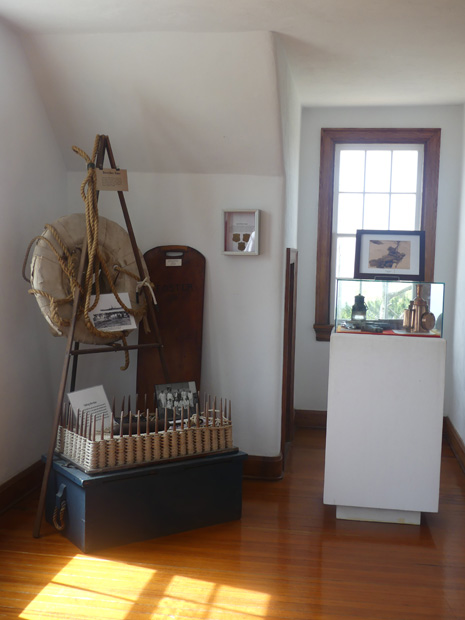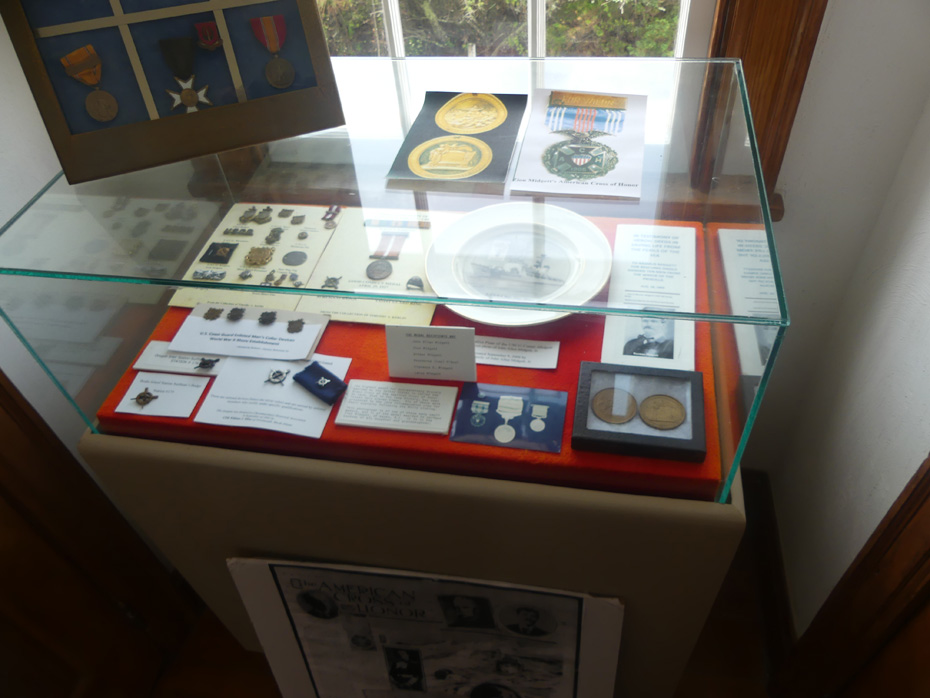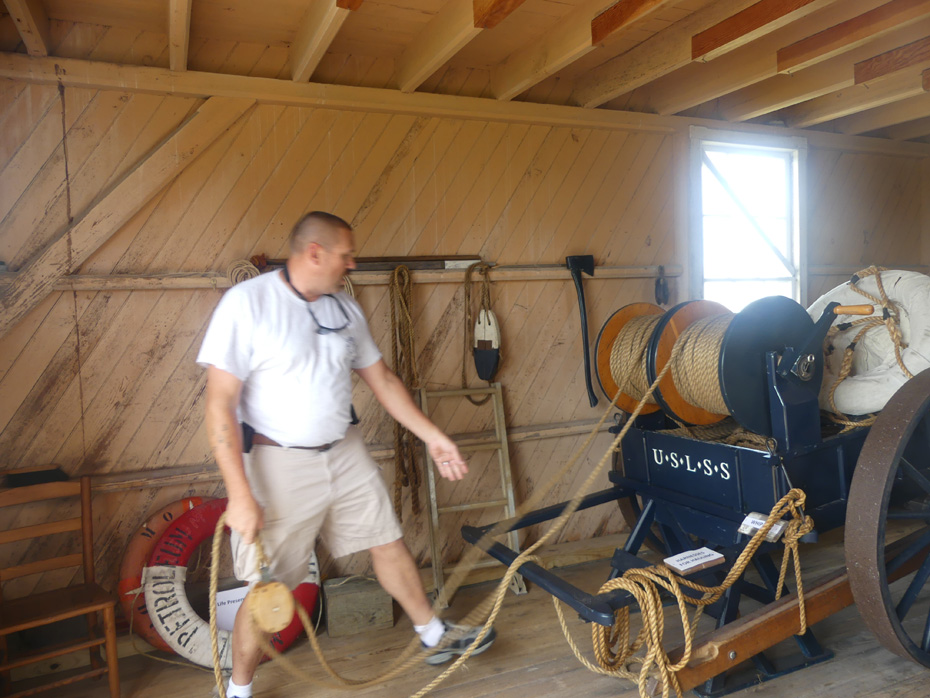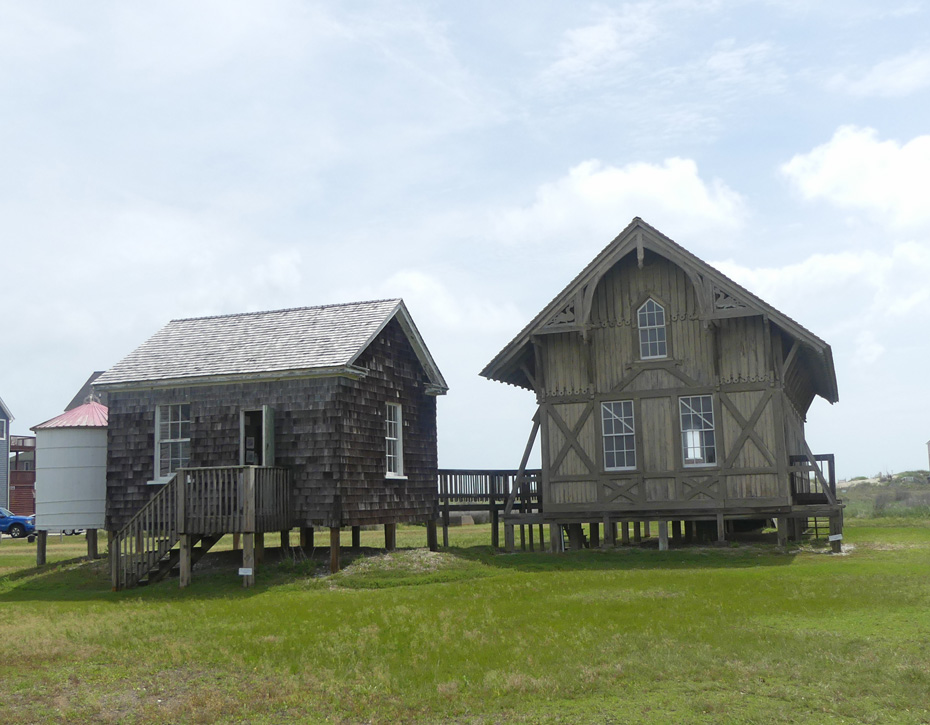
|
|
|
|
Before the days to the Coast Guard guarding our shores to prevent shipwreck deaths, another facility was hard at work. Chicamacomico Lifesaving Station fought to prevent drowning death in the Outer Banks since 1874. Their museum is one of the most complete U.S. Lifesaving Stations left in the country. The present station was constructed in 1911. It's located on Rodanthe. The name means shifting or sinking sand and considering its beach location that is so appropriate.
Larry Grubbs, vice president of the Chicamacomico Historical Association, met us and told about the station's history. Both before and as after the creation of the Coast Guard, the men of the Chicamacomico Station saved many lives. One famous rescue was of Priscilla on Aug 12 1899. Rasmus Midgett was a surfman who had trained at Chicamacomico. He was on patrol at Gull Shoals station when he spotted the Priscilla. Larry explained how the surfmen worked. "When a surfman went on patrol, he would walk or ride his horse The stations were about 7 miles apart. The surfmen would patrol about three and a half miles and meet a surfman from the next station. They would exchange surfchecks. A surfcheck was a little coin with some indentation on it. They would then return to their station and show the coin to their keeper. The keeper would then know they had preformed their patrol."
Rasmus spotted the sinking Priscilla off shore during one of the worst storm to hit the Outer Banks. Since he was over two miles from his station, he knew it would take him three hours or more to return to the station for help. So he tackled the situation himself in an unbelievable show of bravery. He struggled against the waves seven times and swam out to the Priscilla and brought back a survivor to shore each time. The last three were too badly injured to jump off the wreck so he went onboard the sinking vessel and dragged them to safety. Once he had all ten men safe he returned to his station for help with the three who were unable to walk. His feat ranks among the Coast Guard’s top ten rescues of all time. Midgett was awarded the Gold Lifesaving Medal. There is a photo of Rasmus’s great-great grandson displaying Rasmus's award on display at Chicamacomico Lifesaving Station. You'll hear an audio of the grandson, Ernie Foster, telling the story of his great-great grandfather's heroic rescue. There is a door from the Priscilla here also that was given Rasmus as a thank you from the captain of the Priscilla. Finally the government realized a need to aid these struggling rescuers. On January 28, 1915, President Woodrow Wilson signed the "Act to Create the Coast Guard," merging the Life-Saving Service with the Revenue Cutter Service to create the United States Coast Guard. Another of the historic highlights of the life saving station happened on August 16, 1918 during WWI. The British tanker, Mirlo, was torpedo by a German U boat. John Allen Midgett launched the surf boat. He and his crew went out about five miles and rescued 42 of the 51 men on the Mirlo. Rasmus’s son Arthur Vanburen Midgett, who took part in the Mirlo rescue as one of Chicamacomico Station’s surfmen, also received a gold medal. Larry gave us a verbal description of the horror these men faced."Keep in mind the Mirlo was loaded with gasoline. The sea was on fire. After having been torpedoed the boat was burned, the men were burned, the uniforms were burned. They were in really bad shape."
The station is filled with relics of the bravery and the things these men faced over the years. You can ascend to the top and gaze out over the ocean as hundreds of station watchers did over the years. Be sure to watch the film downstairs about the station drills.
The present building was constructed in 1911. You can walk back to the original 1874 building where the boat and all the equipment are kept. The Mirlo rescue surf boat sits in there. The original kitchen where many a surfman and rescued sailor must have eaten a simple meal is next to the boathouse.
This August will mark the centennial. The station is hosting a weeklong celebration beginning on August 13. One of the events will be a meeting of the descendents of the rescued British seamen and descendants of the Chicalacomico rescuers. Because of the ever present danger of drowning their motto is "You have to go out, but you don't have to come back." This little known rescue station is well worth a visit to understand the Outer Banks. For more info: https://chicamacomico.org
|
Connect with us on:
American Roads and | ||||
|
Public Disclosure--
Please Read I recently learned of a FTC law requiring web sites to let their readers know if any of the stories are "sponsored" or compensated. American Roads and Global Highways' feature writers are professional travel writers. As such we are frequently invited on press trips, also called fam trips. Most of the articles here are results of these trips. On these trips most of our lodging, dining, admissions fees and often plane fare are covered by the city or firm hosting the trip. It is an opportunity to visit places we might not otherwise be able to visit and bring you a great story. However, no one tells us what to write about those places. All opinions are 100% those of the author of that feature column. |
|||||
|
Privacy Policy/ Archives /
Contributors /
Subscribe to
American Roads Books by
Kathleen Walls /
Contact /
Sponsor or Advertise/ American Roads & Global Highways Home Page
|














